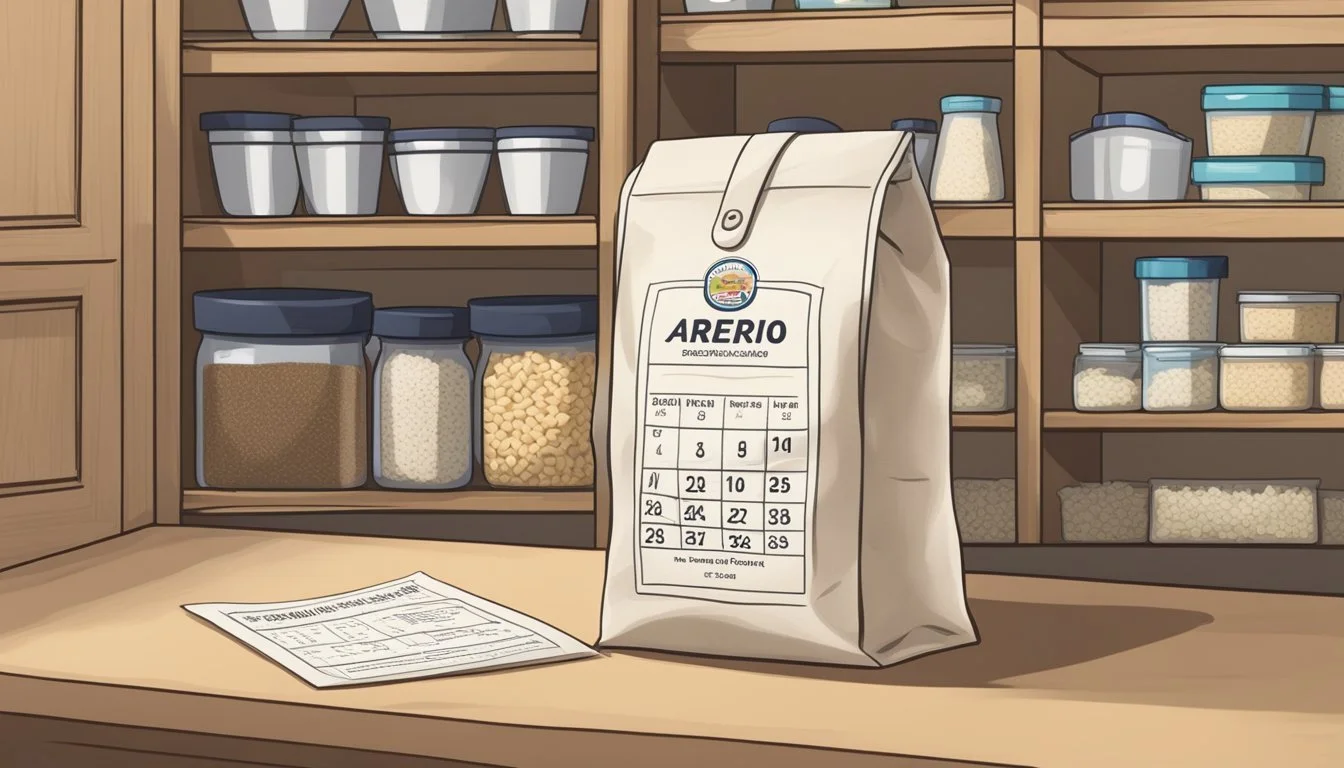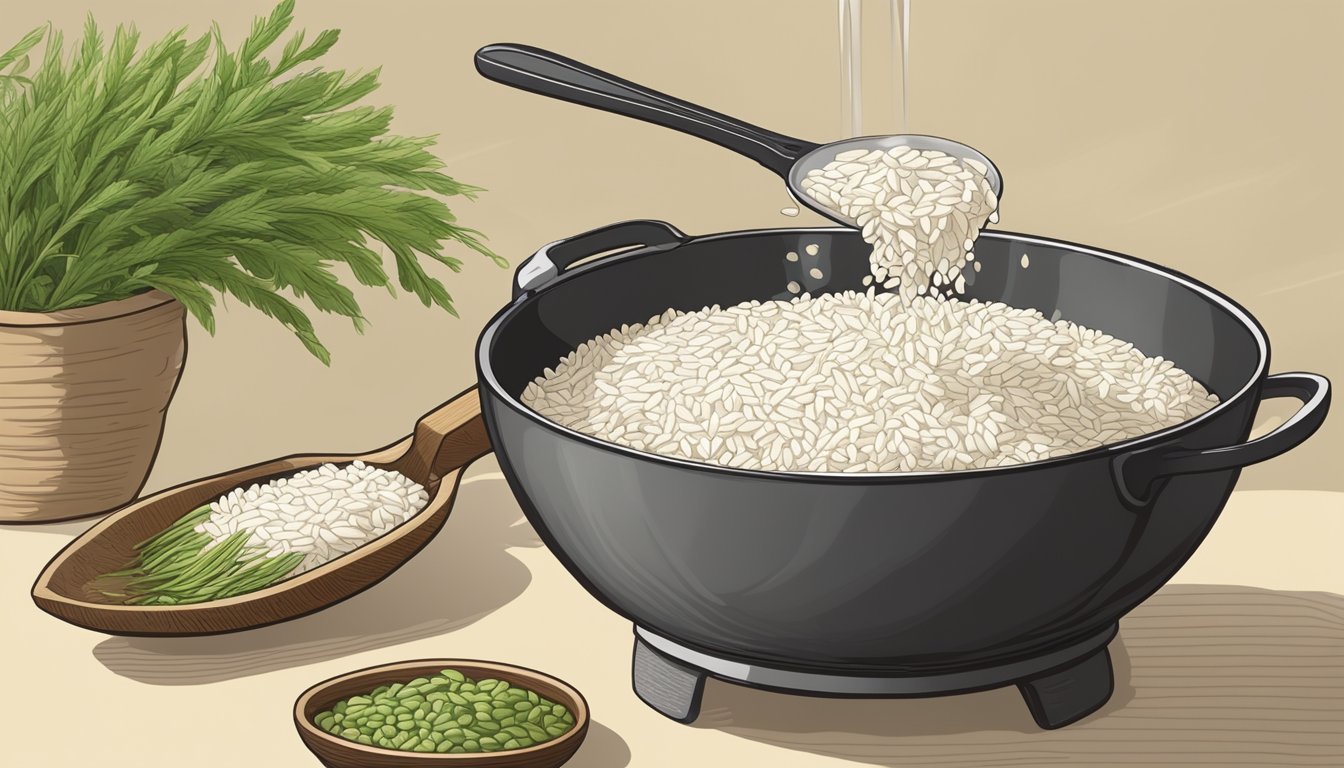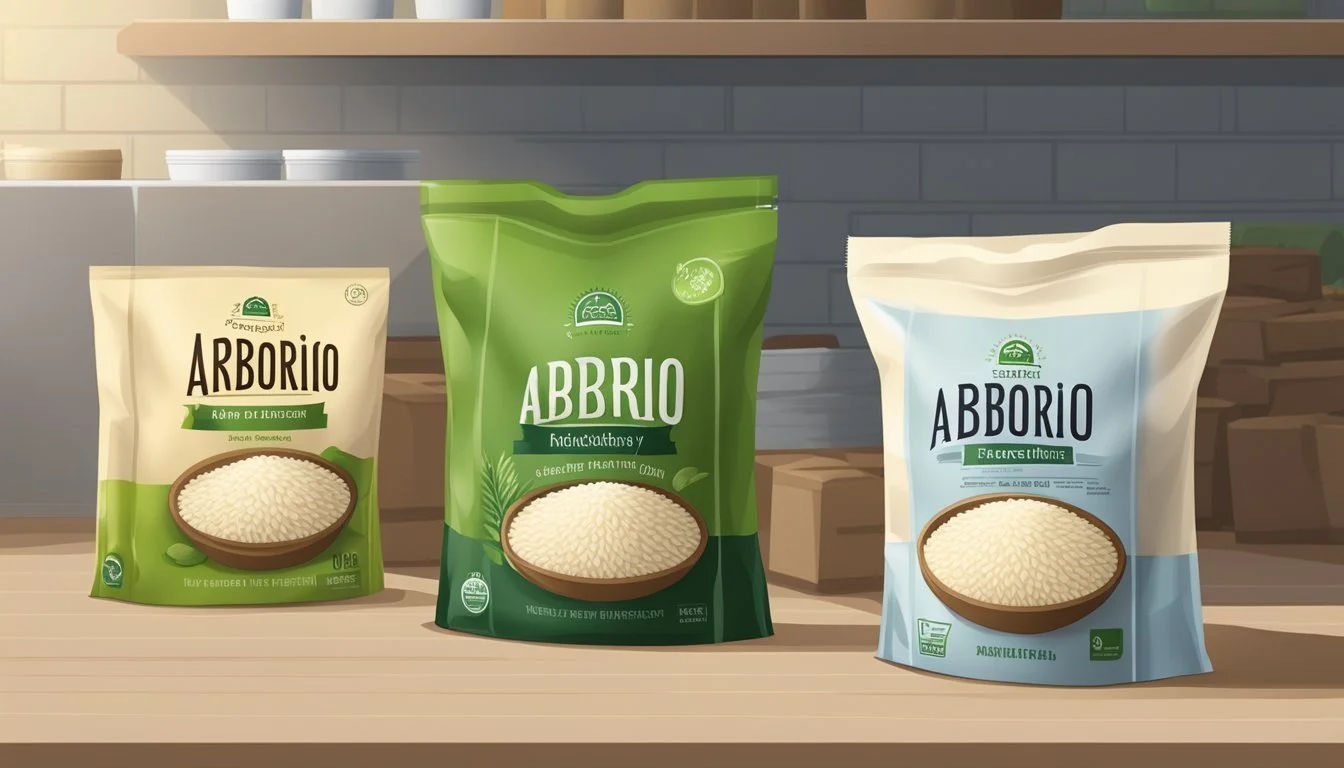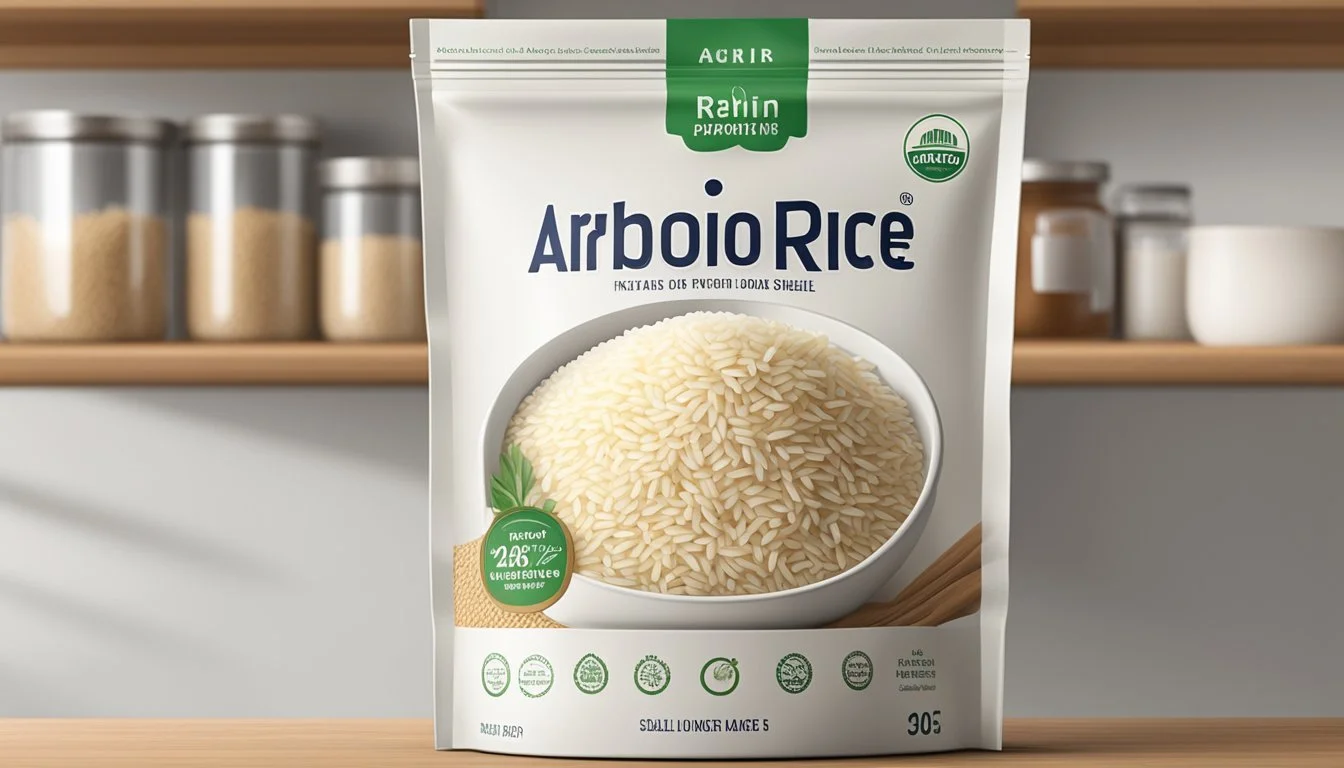How Long Does Arborio Rice Last?
Shelf Life and Storage Tips
Arborio rice (What wine goes well with rice?), a type of short-grain rice named after the town of Arborio in Italy, is well-known for its firm texture and ability to absorb flavors, making it a preferred choice for dishes such as risotto. As with all types of rice, arborio rice has a considerable shelf life, but it requires proper storage to maintain its quality and extend its usability. Shelf life varies depending on whether the rice is raw or cooked, but generally, arborio rice in its dry form can last very long if stored correctly.
The longevity of rice is attributed to its low moisture content which inhibits the growth of spoilage organisms. Under optimal conditions, dry arborio rice has an indefinite shelf life, remaining safe to consume far beyond its best-by date, granted that it has been kept free from contaminants. Storing rice in a cool, dry place away from light, in an airtight container, is crucial to preventing moisture and pests from compromising its quality.
While uncooked arborio rice may last indefinitely under perfect storage conditions, cooked arborio rice has a shorter shelf life despite its sturdy grain structure. Cooked rice (how long does cooked rice last?) should be refrigerated in a covered airtight container to prevent the proliferation of bacteria and maintain quality. Consequently, the shelf life of cooked rice is significantly reduced to just a few days in the refrigerator, but it can be extended by freezing, making proper storage practices vital for food safety and flavor retention.
Understanding Arborio Rice
Arborio rice, named after the town of Arborio in Italy, is a short-grain rice known for its ability to absorb liquids and flavor, leading to its use in classic Italian dishes such as risotto. Characterized by its stout, almost oval shape, it has a high starch content, particularly of amylopectin, which is responsible for the rice's creamy texture once cooked.
When cooking Arborio rice, its creamy texture is achieved due to the gradual release of starch during the cooking process. Here's what contributes to its properties and use in various dishes:
Short-grain: The small size of Arborio rice grains is essential for dishes where a creamy consistency is desired.
High starch content: Arborio rice contains more starch than many other types of rice.
Key Components:
Starch: Primarily made up of amylopectin, which contributes to the creaminess.
Amylopectin: A type of starch that significantly influences texture.
Popular Dishes:
Risotto: A quintessential Italian dish, creamy and rich.
Rice Pudding: Arborio's creaminess works well with sweet dishes too.
Paella: Although not traditional, Arborio can be used as a substitute in this famous Spanish dish due to its ability to hold flavor and maintain a firm texture.
Although it originates from Italy, Arborio rice's cultivation has now spread to other parts of the world, including the United States. Its versatility in both savory and sweet dishes makes it a staple ingredient in a variety of cuisines, well beyond its Italian roots.
Storage Fundamentals
Proper storage is essential for maintaining the shelf life and quality of Arborio rice. By understanding and managing factors such as air exposure, humidity, and temperature, the longevity of both uncooked and cooked rice can be optimized.
Dry Storage Conditions
Uncooked Arborio rice should be kept in a dry, cool place away from light and heat to maintain its quality. An airtight container is preferable to protect the rice from moisture and air, which can negatively impact its shelf life. A pantry or cupboard away from any heat source serves as an ideal storage location. Keeping uncooked Arborio rice in these conditions can significantly extend its shelf life, potentially allowing it to remain safe for consumption for years.
Temperature: Aim for a constant temperature between 50°F and 70°F.
Humidity: Keep it below 60% to deter pests and mold formation.
Light: Store away from direct sunlight which can degrade rice quality over time.
Airtight Container: Crucial for preventing moisture and air from spoiling the rice.
Refrigeration and Freezing
For cooked Arborio rice, refrigeration is necessary to limit the growth of bacteria and reduce the risk of food poisoning. It should be stored in an airtight container to keep out moisture and other contaminants. Under these conditions, cooked Arborio rice can last in the refrigerator for 4 to 6 days.
When freezing, ensure that the rice has cooled before transferring it to an airtight container or freezer bag. Freezing can extend the storage life of cooked Arborio rice to around one month. However, it's important to thaw it properly before reheating to maintain quality and ensure safety.
Refrigerator: Store in airtight containers for 4 to 6 days.
Freezer: Use freezer bags or containers, lasts approximately 1 month.
Thawing: Thaw in the refrigerator or use a microwave for quick reheating.
Assessing Rice Quality
When it comes to Arborio rice, understanding the signs of spoilage and how to assess the quality is essential for ensuring maximum freshness and safety for consumption.
Determining Spoilage
One must be vigilant about identifying expired rice, as consuming spoiled Arborio rice can lead to foodborne illnesses. Shelf life varies depending on storage conditions, but generally, uncooked Arborio rice has a long shelf life if kept in a cool, dry place. Cooked Arborio rice, however, should only be kept for a few days in the refrigerator before its quality begins to deteriorate.
Visual and Olfactory Signs
Assessing the quality of Arborio rice involves both visual and olfactory examination. They should look for changes in color, such as dark spots or discoloration which could indicate mold growth. Any presence of mold suggests that the rice is no longer fit for consumption. Furthermore, a rancid or off smell is a clear sign of spoilage, often caused by bacteria or degradation of oils in the rice. Rice that appears oily or has an unusual texture may also be past its prime. Freshness can consistently be determined by the rice's firm and glossy appearance, free of blemishes.
Preparing and Cooking Arborio Rice
Optimal preparation and cooking of Arborio rice are crucial for achieving the perfect texture and flavor. This section focuses on effective cooking techniques and how to achieve the ideal consistency, which are essential whether one is aiming for a creamy risotto or another Italian dish where the unique properties of Arborio rice shine.
Cooking Techniques
Arborio rice, a staple in Italian cooking, is often used in recipes that require a creamy texture like risotto. It is characterized by its high starch content, which contributes to its creaminess.
Stovetop: Traditional risotto is made by sautéing rice in a heavy pan, slowly adding broth, and stirring constantly. Broth is added gradually, and the rice is allowed to absorb the liquid to become al dente.
Oven Baking: While less traditional, Arborio rice can be baked in the oven. A 2:1 ratio of liquid to rice is commonly used, and the rice absorbs the liquid as it bakes, becoming tender.
Instant Pot: For a faster alternative, using a pressure cooker like an Instant Pot speeds up the process while still yielding a creamy texture. The key is to preheat the cooker, add oil, and follow with the rice and liquid.
Microwave: Although not common for achieving the traditional creamy texture, Arborio rice can be cooked in the microwave when time is of the essence, using a bowl with a lid to steam the rice with an appropriate amount of water.
Ideal Consistency
Achieving the ideal consistency for Arborio rice dishes involves understanding how its starches behave during the cooking process.
Risotto: The goal is a creamy, velvety consistency with each grain maintaining some bite – "al dente". This is achieved by toasting the rice first to lock in the starchy coating and then adding hot broth or stock incrementally, allowing for a slow release of starch.
General Cooking: For dishes other than risotto, the rice should still be cooked until it is al dente, with a slight chewiness. Properly cooked, Arborio rice should be creamy but not mushy, often leaving a starchy, fluffy bed ideal for absorbing the flavors of other ingredients.
Maximizing Shelf Life
Extending the duration that Arborio rice maintains its quality hinges on implementing proper storage techniques and preservation methods. These practices ensure the rice remains free from spoilage and retains its flavor and texture for future use.
Proper Rice Storage Techniques
One should store Arborio rice in an airtight container to shield it from moisture and air, which can quickly degrade its quality. For optimal results, the container should be placed in a cool, dark pantry. Exposure to light and fluctuating temperatures can also diminish rice quality, hence a stable environment is favorable.
Pantry Storage: For uncooked Arborio rice, a pantry should suffice, leading to a shelf life of up to 5 years.
Refrigeration: If residing in warmer climates or for added precaution, refrigerating uncooked rice can prevent insect infestation and further ensure longevity.
Utilizing Preservation Methods
Beyond basic storage, one can use specific preservation methods to maximize the shelf life of Arborio rice.
Dry Storage: A pantry at 50°F (10°C) is considered ideal for storage. Employ oxygen absorbers if storing at 70°F (21°C) to potentially extend shelf life to 10 years.
Freezing: For cooked Arborio rice or leftovers, freezing is commendable. Store rice in freezer-safe containers or bags. Thawing and reheating should be handled with care to maintain rice quality.
By adhering to these guidelines, consumers can confidently maintain the freshness and edibility of their Arborio rice.
Rice Alternatives and Comparisons
When considering alternatives to arborio rice, it is important to evaluate how different rice types and their unique properties can affect a dish, such as texture, cook time, and nutritional content.
Substituting Different Rice Types
Arborio rice, known for its starchy quality and ability to absorb liquids well, is a staple in Italian dishes such as risotto. While arborio rice is ideal for achieving the creamy and al dente texture characteristic of risotto, other rice varieties can serve as substitutes depending on the desired outcome of a recipe.
Carnaroli rice: Often used in risotto for a similar creaminess.
Jasmine rice (how long does jasmine rice last?): Less starchy, imparting a different texture and a floral aroma, suitable for a lighter dish.
Long-grain rice: Varieties like basmati may result in a fluffier and less creamy product, often used in side dishes or pilafs.
High-starch, short-grain rice: Can mimic arborio rice's creamy texture to some extent, useful in rice puddings.
Brown rice: Offers a whole-grain, fibrous alternative with a chewier texture and requires a longer cooking time.
Wild rice (how long does wild rice last?): Not a true rice but can be used for its nutty flavor and hearty texture in salads and side dishes.
Nutritional and Culinary Differences
Different types of rice contribute varied nutritional profiles and culinary properties to a dish. The presence of the bran and germ in whole-grain rice, such as brown rice, provides additional nutrients but also impacts how the rice cooks and integrates with other ingredients.
Arborio rice: High in starch, primarily amylopectin, which contributes to its creaminess.
Brown rice: Richer in fiber, vitamins, and minerals due to the intact bran and germ layers.
Basmati rice: Renowned for its distinctive nutty flavor and aroma, often accompanying Indian and Middle Eastern cuisines.
Jasmine rice: Aromatic, with a slightly sweet flavor profile, commonly paired with Thai dishes.
Wild rice: High in protein and dietary fiber, it is a nutritious addition to a meal.
When using a rice cooker, adjustments may be required for water ratios and cooking times, as each rice type has its own specific needs to achieve the desired texture, from fluffy to creamy. For example, rice pudding might generally need a starchy rice like arborio, but basmati can be used for a less rich texture. Paella, a traditional Spanish dish, typically uses bomba rice, but arborio can be a substitute due to its ability to absorb large amounts of liquid and retain a firm, al dente kernel.
Health and Safety Considerations
When considering the health and safety aspects of storing Arborio rice, it is essential to focus on preventing food poisoning and understanding potential contaminants. These precautions ensure both the longevity of the rice and the safety of those consuming it.
Avoiding Food Poisoning
Proper storage of Arborio rice is crucial to avoid food poisoning. Cooked rice should ideally be consumed within a few hours. If storing leftovers, they must be cooled quickly and placed in the refrigerator within two hours to prevent the growth of Bacillus cereus, a bacteria that can cause food poisoning. When reheating cooked rice, it should be thoroughly heated to 165°F (74°C) to ensure any present bacteria are destroyed.
Leftovers Storage Tips:
Cool rapidly: Spread on a tray or shallow container.
Refrigerate: Store below 40°F (4°C).
Cover: Use airtight containers to prevent contamination.
Reheat: Only reheat once and ensure rice reaches a hot, steamy temperature throughout.
Understanding Contaminants
Uncooked Arborio rice features a longer shelf life; however, proper storage is essential to guard against contaminants that can shorten its usability. It should be kept in a cool, dry place away from direct sunlight to hinder the growth of mold or bacteria. Moreover, the rice must be sealed to protect against dust, insects, and other contaminants, all of which can compromise both the safety and quality of the rice.
Proper Storage for Uncooked Rice:
Temperature: Keep in a cool, dry area.
Containers: Use airtight, opaque containers to block out light and moisture.
Environment: Avoid areas prone to temperature fluctuations which may lead to condensation and moisture build-up.
Maintaining these standards will significantly reduce the risks tied to foodborne illness and spoilage while assuring the safe consumption of Arborio rice.
Reheating and Leftovers
When it comes to reheating Arborio rice, which is often used for dishes like risotto, maintaining its creamy texture while ensuring food safety is crucial.
Best Practices for Reheating Arborio Rice
Arborio rice, due to its starchy nature, requires careful reheating to preserve its characteristic creaminess. To safely reheat cooked Arborio rice, one must reach a temperature of 165°F to eliminate potential bacteria. Here are recommended methods:
Microwave: Place the rice in a microwave-safe dish, sprinkle some water to prevent drying out, and cover it with a suitable lid or a microwave-safe plastic wrap. Reheat on high for intervals of 2 minutes, stirring in-between to ensure even heating.
Stovetop: Add the rice to a pot with a small amount of water or broth. Cover and heat on a low flame, stirring occasionally to prevent sticking and ensure even warming.
Oven: Preheat the oven to 300°F. Put the rice in an oven-safe dish, lightly moisten with water or broth, and cover with foil. Heat for approximately 20 minutes or until thoroughly warm.
Steam: If you prefer steaming, place the rice in a steamer for several minutes until it's hot. This method helps in retaining moisture.
Regardless of the method, breaking up any clumps in the rice before reheating ensures more uniform warming. It is also important not to reheat rice more than once, as this increases the risk of foodborne illness.










